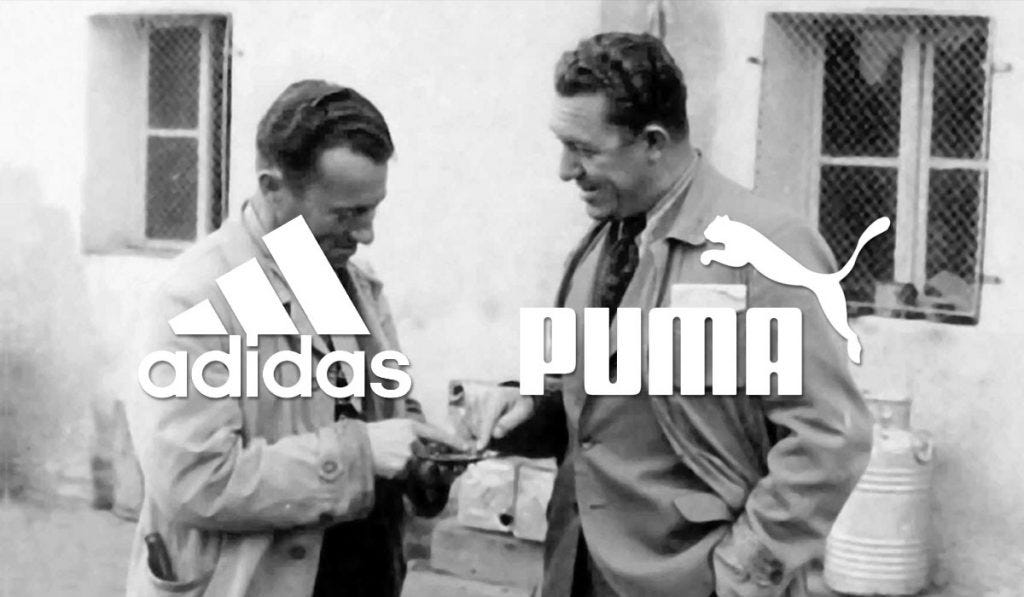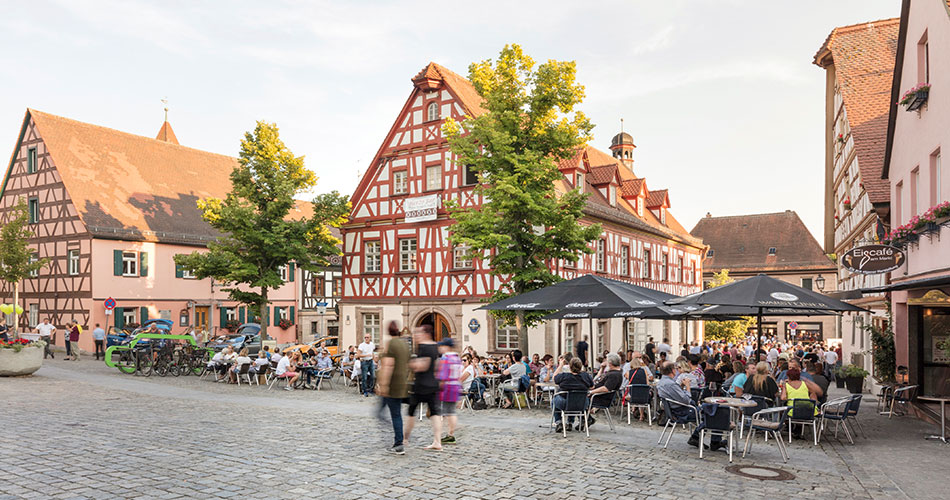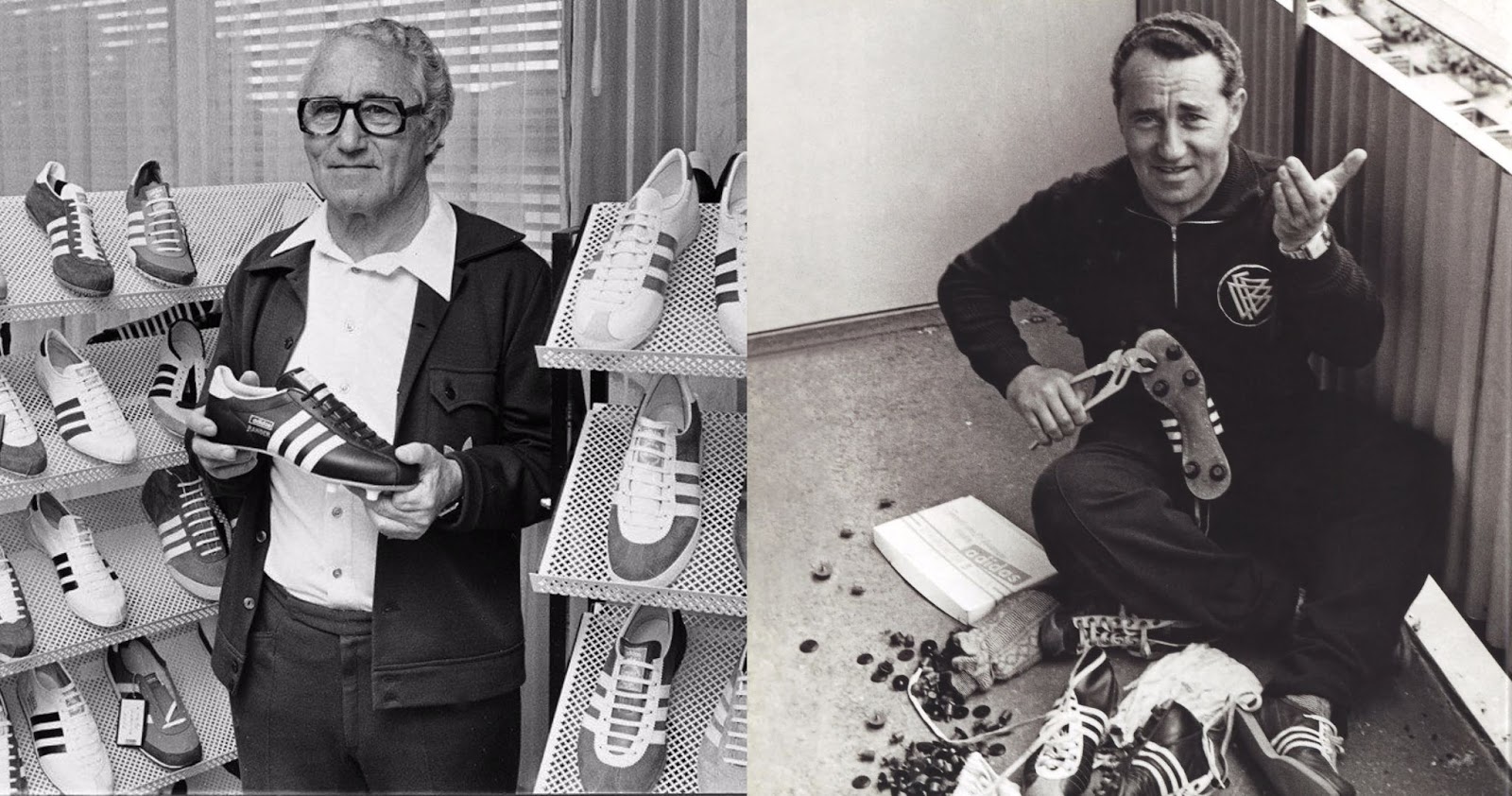Adidas vs. Puma
A Family Feud That Changed the Sportswear World
In a previous article, we explored the high-stakes branding war between Adidas and Nike – the battle for dominance in a market defined by celebrity endorsements, lifestyle marketing, and sneaker-head culture. But before Adidas took on Nike, it had a much more personal rivalry to contend with – one that began not in a boardroom or on a basketball court, but at the kitchen table of a family home in a small German town.
This is the story of Adidas vs. Puma: the sibling rivalry that split a family, divided a town, and built two of the biggest sportswear brands on Earth.
The Marketing Made Clear Podcast
Check out the Marketing Made Clear Podcast on all good streaming platforms including Spotify:
Origins: Born from the Same Boot
To truly grasp the Adidas-Puma rivalry, you need to travel back to the cobbled streets of Herzogenaurach, a quiet Bavarian town nestled along the Aurach river. It’s the kind of place where church bells echo across red-tiled roofs, and back in the early 1900s, most people knew their neighbours by name – and probably worked with them too.
It was here, in 1924, that two brothers, Adolf “Adi” Dassler and Rudolf “Rudi” Dassler, founded the Gebrüder Dassler Schuhfabrik – translated simply as the Dassler Brothers Shoe Factory. The workshop began humbly, operating out of their mother’s laundry room, where a pedal-powered machine was used to stitch the first pairs of handmade athletic shoes.
The brothers were a perfect case study in complementary chaos – Adi, the quiet craftsman, focused on technical precision, and Rudi, the extroverted salesman, was brilliant at building relationships and getting the product into the right hands. Together, they combined product innovation with instinctive marketing acumen, decades before those concepts became textbook marketing fundamentals.
Their big break came at the 1936 Berlin Olympics, an event soaked in propaganda, with Adolf Hitler intent on showcasing Aryan supremacy. But the Dasslers had different plans. Adi personally convinced American sprinter Jesse Owens to wear their custom-made track spikes – an audacious move given the political climate. Owens went on to win four gold medals, shattering both world records and Nazi ideology in one go.
From a marketing perspective, it was revolutionary. Owens’ victories, broadcast and printed around the globe, were intrinsically tied to the shoes he wore. That moment catapulted the Dassler name into international sporting circles and transformed the business from a local shoemaker into a burgeoning international brand.
What’s even more remarkable? This was nearly four decades before Nike was even founded.
By the late 1930s, the Dassler factory was producing over 200,000 pairs of shoes annually, and the brand had carved out a reputation for elite performance footwear.
But as the orders piled up, so too did the pressure – and the cracks in the brothers’ relationship began to show.
A Rift Becomes a Rupture
While their personalities had once complemented each other, they now clashed more than they collaborated. Adi was methodical and introverted, obsessed with refining the technical side of their products. Rudi, charismatic and impatient, wanted faster growth and was less concerned with precision than he was with publicity.
Whether true or not, by the time the war ended, their partnership was unsalvageable.
And so, in 1948, the Dassler brothers went their separate ways – not just as businessmen, but as blood relatives. Adi stayed on one side of the Aurach river and founded Adidas (a blend of his first and last names), while Rudi set up shop on the other bank, initially called Ruda, before being rebranded as Puma.
And just like that, a family feud became a brand war.
Thus began not only one of the most iconic rivalries in the world of sportswear – but also one of the most enduring case studies in branding, competition, and the emotional pull of origin stories.

A Town Divided
Herzogenaurach quickly became known as “the town of bent necks” – because locals would glance down at your shoes before deciding whether they liked you or not. You were either Team Adidas or Team Puma, and there was no in-between. Families split, couples fought, even the town’s two football clubs chose sides.
Local businesses aligned themselves exclusively with one brand or the other, and workers didn’t dare cross company lines – not even for a pint.
From a marketing perspective, this is what you might call hyper-localised brand tribalism.
Before globalisation, before influencer culture, before viral TikToks – these two companies created a brand identity so powerful it reshaped the social dynamics of an entire town.

Innovation as Identity
Adidas: The Technician’s Brand
Adi Dassler was an obsessive innovator.
He kept detailed notes on athletes’ feedback and was known for making shoes tailored to specific performance needs. This obsessive focus on technical superiority has remained a pillar of the Adidas brand. From developing screw-in studs for football boots to pushing the envelope with Boost technology, Adidas has always leaned into function-first innovation, with a cool minimalist brand aesthetic layered on top.
In short: Adidas made the product the hero.
Puma: The Personality Brand
Rudi, on the other hand, was the marketer (surprisingly).
More charming, more aggressive, and more instinctive when it came to brand-building. He understood the power of aligning with personalities. Puma was the first sportswear brand to sign Pelé in the 1970 World Cup – a move that would cement its global reach and still ranks as one of the most iconic endorsements in sports marketing history.
Puma’s brand voice has long been a little bolder, a little more streetwise, and unafraid to chase cultural relevance. It’s no surprise that in recent years, they’ve partnered with the likes of Rihanna, J. Cole, and Neymar.
Competition as a Catalyst
What’s fascinating about the Adidas vs. Puma rivalry is how much it sharpened each brand. The brothers weren’t just building companies; they were actively trying to outdo each other. And this competitive tension led to some of the most aggressive innovation and brand positioning in sportswear history.
It’s a bit like the Coke vs. Pepsi effect – constant one-upmanship that pushes both parties forward. But with Adidas and Puma, there was a personal edge. Every product launch, every athlete signed, every new market entered… it wasn’t just business. It was personal.
And that’s the stuff great brand stories are made of.

Lessons for Marketers
So, what can marketers learn from this decades-long branding battle?
-
Origin stories matter: The Adidas-Puma feud shows how much weight a brand’s backstory can carry. A compelling origin story – especially one with tension or human drama – can deepen emotional engagement.
-
Innovation and brand aren’t enemies: Adidas shows that product innovation can become your brand story, especially if told consistently across decades.
-
Endorsements aren’t just about fame: Puma’s success with athletes like Pelé and entertainers like Rihanna wasn’t just about celebrity – it was about brand alignment. The endorsements felt authentic and culturally savvy.
-
Rivalries can sharpen your edge: Healthy competition forces clarity. If you know who you’re up against, you know who you need to be.
From Rivalry to Reconciliation?
There’s a semi-happy ending to this saga.
In 2009 – over 60 years after the split – employees from Adidas and Puma symbolically came together for a handshake football match in Herzogenaurach, an act of public reconciliation.
But make no mistake: the rivalry still simmers.
While Adidas continues to battle Nike on a global scale, Puma has found success by carving out a niche as the edgier, style-focused alternative.
Their family feud may have ended in a truce, but the brand war? That’s still alive and well.
Final Thoughts
While Nike vs. Adidas is a story of market share, cultural dominance, and style battles, Adidas vs. Puma is a story of pride, betrayal, and legacy. It’s a reminder that behind every brand is a story – and behind every story, a person.
And sometimes, the most powerful marketing isn’t manufactured in a campaign – it’s forged in real life, over time, through conflict, innovation, and a relentless desire to win.
Just ask the Dassler brothers.


